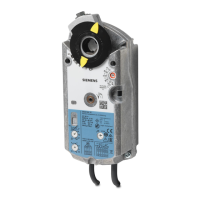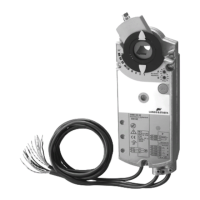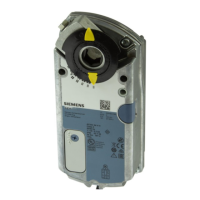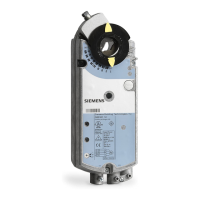13/44
Siem ens GMA..1 actuators with spring return CM2Z4614en
Building Technologies 2018-01-11
3.3 Auxiliary switches and positioning signals
The illustration below shows the relationship between the rotary angle, the adjustable
switching points for auxiliary switches A and B, and the positioning signal.
Gear train rotary range
Inner mechanical limits
S1 S1 S4 S4
S2 S3 S2 S3 S5 S6 S5 S6
(Q12)
(Q14)
(Q14)
(Q12)
(Q22)
(Q24)
(Q22)
(Q24)
(Q11)
(Q11)
(Q21)
(Q21)
0°
0°
0°
A B
85°
5°
⇑
1 x click
95°
95°
0° 95°
5°
4614D11
1
2
3
4
5
6
7
8
9
10
95°
5
0
4
0
3
0
2
0
1
0
6
0
8
0
9
0
A
B
4614Z03en
Aux Switch
Adjustment
[ ° ]
Auxiliary switches
Factory setting:
A = 5°; B = 85°
Setting range 5°…90°
Switching states
Rotary movement as a function
of the positioning signal
Modulating signal, DC 0…10 V
AC 24 V/DC 24…48 V
• no movement (G,G0,Y=U)
‚ opening (G,G0,Y>U)
ƒ closing (G,G0,Y<U or G,G0)
„ Spring return function
(no voltage)
Tree-position signal
AC 24 V/DC 24…48 V
… no movement (G,G0)
† opening (G,G0,Y1)
‡ closing (G,G0,Y2
or G,G0,Y1,Y2)
ˆ Spring return function
(no voltage)
Two-position signal
AC 24 V/DC 24…48 V;
AC 230 V
‰ opening (G,G0 or L,N)
Š Spring return function
(no voltage)
The setting shafts for the auxiliary switches turn together with the adapter. The scales
thus only refer to the inner mechanical 0° limit.
The adjustment tool is used to set the auxiliary switches; it is part of the delivery (type-
specific).
Electrical functions
Note
Adjustment tool

